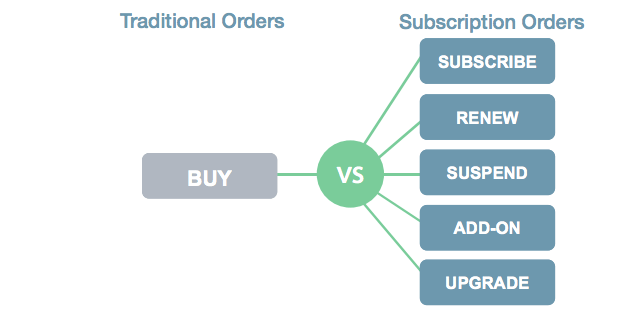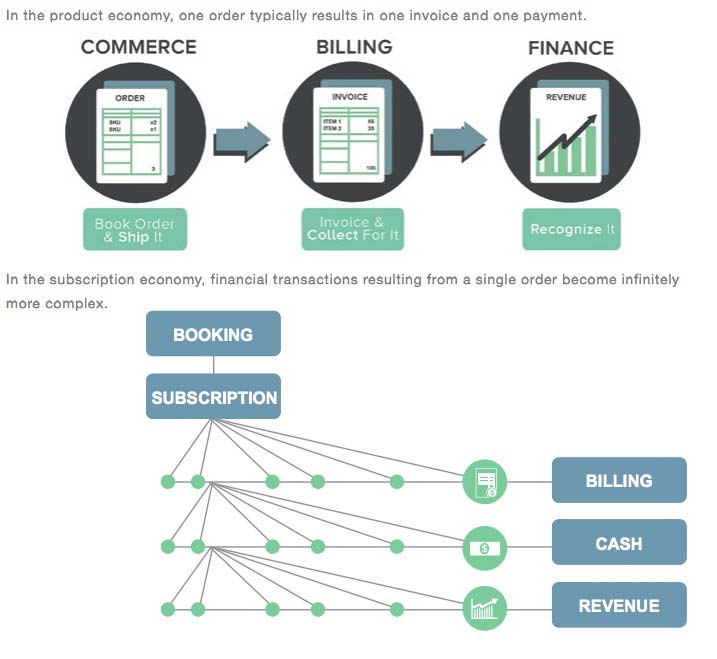Your enterprise resource planning (ERP) systems are the foundation for your recurring revenue business. And while you’ve probably invested more time and resources in them than you’d like to admit, they get the job done. They are your system of record and general ledger. They serve finance and accounting, and if you sell products, they manage your supply chain.
Yet if you’re launching or scaling subscription services, you’re learning that those services have very different needs than one-time sales of physical products. The more you learn, the more you are likely to ask: why can’t I just use or tweak my ERP system to support my subscription services?
This guide will show subscription-based businesses the challenges they are likely to encounter with traditional ERP systems, and how a Relationship Business Management solution can work with their ERP system to support subscription services. RBM isn’t here to replace your ERP, but reinvent it.
Traditional ERP systems from SAP, Oracle, and others were designed for the 20th century manufacturing era to track products that can be put on a pallet. They didn’t anticipate that our economy would shift rapidly from this product-based, “buy-once” world to one centered around recurring customer relationships. They can handle the single-unit pricing of USB storage stick, but not the myriad payment possibilities of cloud-based storage.
Geoffrey Moore, best-selling author and a venture partner at Mohr Davidow Ventures, describes this shift as the difference between systems of record and systems of engagement. “The former are data-centric, operational, reliable, and secure.They are the stuff of the 20-century’s build-out of data processing into management information systems into information technology. The latter are user-experience-centric, provisional, reversible, and open,” characterized by “transactions via intermediating cloud-enabled systems that operate at massive scale and near real-time speed.”
And most ERP systems are just not up to speed with today’s business needs at a more foundational level. Research done by Ventana Research shows that just one in five companies (21%) said it is easy to make changes to ERP systems while one-third (33%) said making changes is difficult or very difficult.
The seven things your current ERP system can’t do for you
It doesn’t understand the concept of time or recurring revenues.
It can’t help you design pay-as-you-go pricing models.
It can’t handle upgrades, downgrades, or add-ons.
It doesn’t understand renewals.
It can’t tell you how many active customers you have.
It can’t let you sell to different kinds of customers.
It can’t give you a unified view of how your business is doing.
Your enterprise resource planning (ERP) systems are the foundation for your recurring revenue business. And while you’ve probably invested more time and resources in them than you’d like to admit, they get the job done—or at least partially get the job done: They are your system of record and general ledger. They serve finance and accounting, and, if you sell products, they manage your supply chain.
But if you’re launching or scaling subscription services, you’re learning that these services have very different needs than the one-time sales of physical products. The more you learn, the more you are likely to ask: Can’t I just use or tweak my ERP system to support my subscription services?
The short answer is…no.
FROM A PRODUCT ECONOMY TO BUSINESS MODELS BASED ON FLEXIBLE CONSUMPTION
Traditional ERP systems from SAP, Oracle, and others were designed for the 20th century manufacturing era to track products that can be put on a pallet. They didn’t anticipate that our economy would shift rapidly from this product-based, “buy-once” world to one centered around recurring customer relationships and recurring billing. They can handle the single-unit pricing of USB storage stick, but not the myriad payment possibilities of cloud-based storage.
Geoffrey Moore, best-selling author and a venture partner at Mohr Davidow Ventures, describes this shift as the difference between systems of record and systems of engagement. “The former are data-centric, operational, reliable, and secure.They are the stuff of the 20-century’s build-out of data processing into management information systems into information technology. The latter are user-experience-centric, provisional, reversible, and open,” characterized by “transactions via intermediating cloud-enabled systems that operate at massive scale and near real-time speed.”
And most ERP systems are just not up to speed with today’s business needs at a more foundational level. Research done by Ventana Research shows that just one in five companies (21%) said it is easy to make changes to ERP systems while one-third (33%) said making changes is difficult or very difficult.
The seven things your current ERP system can’t do for you:
- It doesn’t understand the concept of time or recurring revenues.
- It can’t help you design pay-as-you-go premium pricing models.
- It can’t handle upgrades, downgrades, or add-ons.
- It doesn’t understand renewals.
- It can’t tell you how many active customers you have.
- It can’t let you sell to different kinds of customers.
- It can’t give you a unified view of how your business is doing.
AUTOMATING COMPLEX FINANCIAL TRANSACTIONS
The nature of a subscription relationship with your customers is based on constant change.
Aaron Somer, Principal Sales Engineer, ZuoraYou want to make it easy for customers to add more services whenever they want. You want to cross-sell and up-sell. You want to incent your customers to buy more with trials and promotions.
Not surprisingly, each of these customer subscription changes adds up to drive complex financial calculations. They demand a system that aligns all product changes to a customer bill cycle, drives charge pro-rations and pro-ration credits, and simplifies the renewal process for your customers. Finally, they need a system that handles the complex financial calculations needed to provide your customer with a single, intuitive bill.
In the product economy, one order typically results in one invoice and one payment. In the subscription economy, one order leads to multiple billing schedules, multiple collection events, multiple subscription payments, and multiple revenue schedules. ERP systems were not architected to handle the recurring nature of payments, and many lack basic high-volume payment automation capabilities.
When a business sells a subscription to a service, rather than selling a physical product, the whole business model changes. As a result, the way a business measures itself changes. Instead of traditional accounting rules that record orders placed, these revenue recognition rules anticipate renewals, setup fees, and promotions, then track these prices separately.
Subscription-specific metrics include annual contract value (ACV), which calculates the total recurring charges or fees on a subscription. Another, called total contract value (TCV) calculates the total recurring charges over the lifetime of a subscription.
Since independent billing schedules that are not related make these metrics difficult to calculate, your legacy system will need help. Selecting a fully integrated platform with a unique design will give you the flexibility you need to run your subscription business.
Iterating Pricing & Packaging
ERP pricing engines were designed for configuring the price of an item. In this system, an item has a fixed price. It does not have the notion of frequency, or time or consumption levels.
Aaron Somer, Principal Sales EngineerYou need to find something that works alongside your ERP to help you run your subscription business, so that new product and pricing changes can be automated to your sales channels within minutes, without having to burden IT or finance.
It should provide your marketing department with the flexibility to try a new time-based promotion, price point, or even an entirely new price model. And it will be able to save you from draining IT resources on customizing your ERP to roll out a price change.
The capability to change pricing quickly is especially critical as we’ve learned that none of our customers get their subscription pricing right the first time. Successful businesses optimize pricing through A/B testing and trying many different combinations to find what sells the best.
INSTILLING BUSINESS MODEL AGILITY
In the product economy, every order is considered a new sale. Everything changes in the Subscription Economy.
Aaron Somer, Principal Sales EngineerIn the subscription economy, an order can be a new sale, an upgrade, a downgrade, an add-on to an existing subscription, a renewal, or a cancellation.
As your company achieves success with new subscription services, you’ll likely want to look beyond your traditional markets. You may seek to expand your offerings, or support an indirect sales channel with partner resellers. As your business models change, so will your business processes.
For example, a salesperson-driven assisted sales process with quotes and invoices could broaden to a low-touch sales process using web self-service with credit cards. These process changes will create ripple effects across commerce, billing, and finance.
An easy-to-use B2Any platform can help manage change for your subscription business. Expanding or pivoting to new business models should be pre-meditated, easier, and faster.
INTEGRATING YOUR GENERAL LEDGER
The great news is that a subscription-centric system can be integrated into your general ledger and finance systems.
Aaron Somer, Principal Sales Engineer, ZuoraHow? By providing reference architectures that can be used as a starting point to integrate with Oracle, SAP, and other enterprise systems of record.
Look for a system that makes integration to your general ledger fast and compliant by:
- Supporting your chart of accounts, accounting periods, and accounting period close process.
- Respecting the integrity of a closed accounting period, which is useful for auditing and compliance.
- Providing an event-driven, revenue recognition module designed to automate changes to revenue from multiple customer changes.
- Generating a summary journal entry report for entry into your general ledger at the end of an accounting period.
- Enabling integration between the system and your general ledger at the individual billing transaction level.
- Including open, standards-based APIs, an event-driven notification framework, and easy ways to export and merge data and reports into your general ledger.

